#hebridean culture
Text
Today is World Heritage Day
Oiginally known as the International Monuments and Sites Da it is a global celebration of this planet’s heritage. It’s all about increasing the awareness of the importance of the diversity of cultural and natural heritage and preserving this heritage for future generations..
In Scotland we’re lucky enough to have no less than six UNESCO World Heritage Sites. they are;
St Kilda.
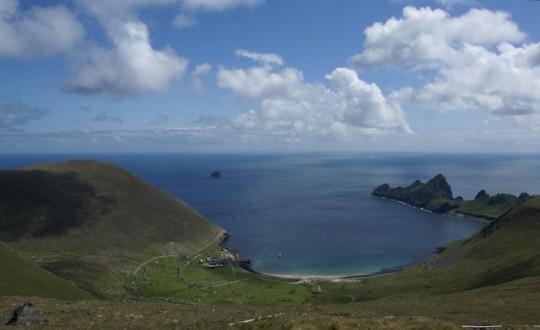
The remote Hebridean island archipelago is one of only two-dozen global locations with World Heritage Status for both natural and cultural significance.
The archipelago shares this honour with natural and cultural wonders such as the Historic Sanctuary of Machu Picchu in Peru and Mount Athos in Greece.
I'd love to visit, but it is a wee bit too expensive for me.
Edinburgh Old and New Towns.

Some people have asked me which part of Edinburgh is covered by this title, well the simple answer is all of it!
The capital is a city of many eras, and its World Heritage Site comprises both the old and new towns. The Auld Toon has preserved much of its medieval street plan and Reformation-era buildings along the wynds of the Royal Mile.
The (relatively) New town contrasts this perfectly with neoclassical and Georgian architecture in regimented order.
Antonine Wall.

I've explored many parts of the wall. Constructed around 142 AD by the Romans, the Antonine Wall marked the north-west frontier of their empire. Stretching from the Firth of Forth and the Firth of Clyde, the Antonine Wall separated the civilised Romans from the wild Caledonians.
The Heart of Neolithic Orkney
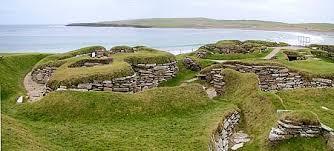
I've not visited The Northen Isles as yet, plans were in the early stages to go this year, but my friend ended up in hospita and is still recuprating, hopefully we can get something sorted when she becomes more able.
The Orkney mainland is synonymous with archaeology. It boasts the mysterious standing stones at the Ring of Brodgar and megaliths at Standing Stones of Stenness, as well as the 5,000-year-old settlement of Skara Brae and chambered cairn and passage grave of Maeshowe. Together these four sites form the heart of Neolithic Orkney, which was given World Heritage status in 1999.
The Forth Bridge

I remember as a bairn drawing and painting the bridge with a steam train going over it, but the train going over the "bumps!"
One of our most iconic and beloved bridges, the Forth Bridge was named a World Heritage Site in 2015 just after its 125th anniversary. The bridge was one of the most ambitious projects of its kind ever attempted at the time. When it opened it had the longest single cantilever bridge span in the world.
New Lanark
The last mill closed in the 1960s but a restoration programme saved the 18th-century village from falling into dilapidation.
It is an early example of utopian socialism in Scotland as well as a planned settlement – making New Lanark an important milestone in the historical development of urban planning. I have never visited, I must say I much prefer my ruined castles and abbeys.
113 notes
·
View notes
Note
I don’t know if this would fit into Pureblood Culture verse, but when I see a Hebridean Black Dragon, I always think it is somehow tied to the House of Black.
It can range at any given moment from “a member of the Black family first found the dragon breed and it’s named after them” to “a member of the House of Black was cursed to become the first Hebridean Black”.
Also, I can’t remember what you mentioned the House of Black’s coat of arms were (was it a unicorn, or is that the Malfoy’s?) and then I was wondering, since families have a secret motto, if they would have a secret crest as well - and now it’s an eternal headcanon in my head that the House of Black’s hidden family crest is a Hebridean Black.
They fly amongst the stars and burn hot as flames, and are as fiercely protective of their family as a nesting mother dragon over her eggs.
That is absolutely beautiful and a wonderful head-canon.
A Black cursed into a Herbridean Black sounds like a fairytale, no?
The unicorns are on the Malfoy crest/coat of arms. 😊
22 notes
·
View notes
Note
hi! i had a question: why did you choose to set the story in st kilda? is there any relation between the story and the evacuation of hirta in ww1? it seems like it's set around that time or maybe before but there isn't really any tourism happening in the podcast
Whilst I personally didn't choose to set the story on St Kilda, I believe I've heard the 'making of' story enough times to get this right!
The original setting for the main story wasn't necessarily St Kilda, it was 'the highlands and islands somewhere'. Someplace isolated, where a culture could develop relatively independent of the Scottish central belt/the rest of the world. In the veeeery first ever script (we're talking 2 page first draft) we don't even leave central Scotland!
The decision to set the story on St Kilda came from research about the Hebrides, looking for a potential island to set the story on. It was an obvious choice - remote even from other outer-Hebridean isles, a bay for docking, and already deserted, so no need to explain what happened to the actual population.
Tsosk is set in an alternate timeline in which Hirta wasn't evacuated/didn't suffer so heavily from a depleting population, and instead has a storied history of hosting a cult. There's no specific year in which the story is set, in part due to the AU. I could give you a rough window of time, but I think Naomi likes to keep you all guessing ;)
And tourism is still possible on the island! It may not seem the case due to how action-packed it was, but season one happened across the course of about 9 days! We just didn't have time to check in with the wider world. Maybe one day!
19 notes
·
View notes
Text
The Eriskay Pony: A Living Legacy of Scotland
The Eriskay Pony, a rare and ancient breed native to the Hebridean island of Eriskay in Scotland, stands as a living testament to the region’s rich cultural and natural heritage. These small yet sturdy ponies have a lineage that stretches back to the times of the Vikings, and they embody a unique blend of resilience, versatility, and historical significance. Today, the Eriskay Pony is not only a…

View On WordPress
0 notes
Text
Flying Fingers in the Fire's Glow #654
Let your fingers fly in the fire’s glow with Irish & Celtic Music Podcast #654. Subscribe now!
Derek Warfield & The Young Wolfe Tones, The Lilies of the Midwest, Nuala Kennedy and Eamon O'Leary, Dàimh, CaliCeltic, Jigjam, Louise Bichan, The Darkeyed Musician, Celtic Wood and Wires, The Whipperginnies, The Walker Roaders, Stout Pounders, Ian Alistair Gosbee, Jimmy & Scots Folk Band, Hayley Griffiths
GET CELTIC MUSIC NEWS IN YOUR INBOX
The Celtic Music Magazine is a quick and easy way to plug yourself into more great Celtic culture. Enjoy seven weekly news items for Celtic music and culture online. Subscribe now and get 34 Celtic MP3s for Free.
VOTE IN THE CELTIC TOP 20 FOR 2024
This is our way of finding the best songs and artists each year. You can vote for as many songs and tunes that inspire you in each episode. Your vote helps me create next year's Best Celtic music of 2024 episode. You have just three weeks to vote this year. Vote Now!
You can follow our playlist on Spotify to listen to those top voted tracks as they are added every 2 - 3 weeks. It also makes it easier for you to add these artists to your own playlists. You can also check out our Irish & Celtic Music Videos
THIS WEEK IN CELTIC MUSIC
0:06 - Derek Warfield & The Young Wolfe Tones "The Flying Fingers Set" from Let the Free Birds Fly
3:34 - WELCOME
5:52 - The Lilies of the Midwest "Three Deer and a Hare - Pangur Ban" from Flora
8:21 - Nuala Kennedy and Eamon O'Leary "Liffeyside" from Single
11:44 - Dàimh "Bog An Lochan" from The Hebridean Sessions
16:48 - CaliCeltic "Hotaling's Whiskey" from Whiskey Mustache
21:23 - FEEDBACK
24:16 - Jigjam "Good Ole Mountain Dew" from Across The Pond
26:56 - Louise Bichan "Coldstream" from The Lost Summer
30:05 - The Darkeyed Musician "Fire's Glow" from Fire's Glow
33:48 - Celtic Wood and Wires "Carraroe Jig & Joy of Life" from Close the Back Door
38:29 - The Whipperginnies "Lady in Grey" from Lady in Grey
46:36 - THANKS
48:10 - The Walker Roaders "Lord Randall's Bastard Son" from The Walker Roaders
52:02 - Stout Pounders "Stark Raving Mad (Live)" from Liver Let Live
55:08 - Ian Alistair Gosbee "Highlands" from Ray of Sunshine
59:17 - Jimmy & Scots Folk Band "THE VIKING IRISHMAN" from The Viking Irishman
1:03:22 - CLOSING
1:04:09 - Hayley Griffiths "Siúil a Ruin" from Far from Here
1:06:58 - CREDITS
The Irish & Celtic Music Podcast was produced by Marc Gunn, The Celtfather and our Patrons on Patreon. The show was edited by Mitchell Petersen with Graphics by Miranda Nelson Designs. Visit our website to follow the show. You’ll find links to all of the artists played in this episode.
Todd Wiley is the editor of the Celtic Music Magazine. Subscribe to get 34 Celtic MP3s for Free. Plus, you’ll get 7 weekly news items about what’s happening with Celtic music and culture online. Best of all, you will connect with your Celtic heritage.
Please tell one friend about this podcast. Word of mouth is the absolute best way to support any creative endeavor.
Finally, remember. Refuse, reduce, reuse, recycle, and think about how you can make a positive impact on your environment.
Promote Celtic culture through music at http://celticmusicpodcast.com/.
WELCOME THE IRISH & CELTIC MUSIC PODCAST
* Helping you celebrate Celtic culture through music. I am Marc Gunn.
This podcast is here to build a diverse Celtic community and help the incredible artists who so generously share their music with you. If you hear music you love, please email artists to let them know you heard them on the Irish and Celtic Music Podcast. Musicians depend on your generosity to keep making music. So please find a way to support them. Buy a CD, Album Pin, Shirt, Digital Download, or join their communities on Patreon.
You can find a link to all of the artists in the shownotes, along with show times, when you visit our website at celticmusicpodcast.com.
If you are a Celtic musician or in a Celtic band, then please submit your band to be played on the podcast. You don’t have to send in music or an EPK. You will get a free eBook called Celtic Musicians Guide to Digital Music and learn how to follow the podcast. It’s 100% free. Just email Email follow@bestcelticmusic and of course, listeners can learn how to subscribe to the podcast and get a free music - only episode.
THANK YOU PATRONS OF THE PODCAST!
You are amazing. It is because of your generosity that you get to hear so much great Celtic music each and every week.
Your kindness pays for our engineer, graphic designer, Celtic Music Magazine editor, promotion of the podcast, and allows me to buy the music I play here. It also pays for my time creating the show each and every week.
As a patron, you get music - only episodes before regular listeners, vote in the Celtic Top 20, stand - alone stories, and you get a private feed to listen to the show. All that for as little as $1 per episode.
A special thanks to our Celtic Legends: Bill Mandeville, Marti Meyers, Brenda, Karen DM Harris, Emma Bartholomew, Dan mcDade, Carol Baril, Miranda Nelson, Nancie Barnett, Kevin Long, Gary R Hook, Lynda MacNeil, Kelly Garrod, Annie Lorkowski, Shawn Cali
HERE IS YOUR THREE STEP PLAN TO SUPPORT THE PODCAST
Go to our Patreon page.
Decide how much you want to pledge every week, $1, $5, $25. Make sure to cap how much you want to spend per month.
Keep listening to the Irish & Celtic Music Podcast to celebrate Celtic culture through music.
You can become a generous Patron of the Podcast on Patreon at SongHenge.com.
TRAVEL WITH CELTIC INVASION VACATIONS
Every year, I take a small group of Celtic music fans on the relaxing adventure of a lifetime. We don't see everything. Instead, we stay in one area. We get to know the region through its culture, history, and legends. You can join us with an auditory and visual adventure through podcasts and videos. Learn more about the invasion at http://celticinvasion.com/
#celticmusic #irishmusic #celticmusicpodcast
I WANT YOUR FEEDBACK
What are you doing today while listening to the podcast? Please email me. I’d love to see a picture of what you're doing while listening or of a band that you saw recently.
Email me at follow@bestcelticmusic.
James OConnor emailed: "Jim from Boston Blackthorne here. St Patricks week will be a fun one for us with a little festival in Northampton MA on March 9 then on the 15th we are opening for the Dublin City Ramblers at the Colony Theatre in Woodstock NY. Next night in the Berkshires at the Heritage House in Lenox MA. We end the season as usual at Brennan’s on the Holyoke Parade route with all 5 original members for our 20th year!
Hope you have a wonderful month and thanks for all you have done for Boston Blackthorne!"
Darin Wallace emailed: "Hi Marc! And an early Happy Birthday to you! ���️
Stout Pounders is my band and you know us. We will be celebrating by playing several gigs, starting with a show on March 10 in Spokane, WA at the Knitting Factory with the legendary Young Dubliners. So if you could add one of our songs and one of theirs to your podcast list that would be great!!! We have a newer live album streaming on all major platforms that I submitted to you a little while ago, but anything you like of ours is fine by me.
We will also be Headlining a show March 14 at the Spanish Ballroom at the McMenamins Elk Temple location in Tacoma with an opening band called Slainte and accompanied by the Seattle Irish Dance Company who will be dancing throughout the evening to the band's songs and in between. Will be a heck of a Pre - Paddy's Party.
We play Shawn O'Donnell's Everett location on Friday the 15th, The Blarney Stone Pub in Seattle on the 16th, and March 17 THE BIG DAY we are the band for the 40th Anniversary of Seattle's longest running (pun intended) 5K St. Paddy's Day Dash. The later that day back at O'Donnell's in Everett to cap off the day and week of fun.
Hope yours is a good one too! Thanks for all you do for us Indy Celts!"
Check out this episode!
0 notes
Text
Excerpts from A Very Civil People: Hebridean Folk, History and Tradition (2000, John Lorne Campbell; Edited by Hugh Cheape)
Father Allan McDonald’s Diary for March 1898
The diary was kept in Gaelic during this month. This is a translation by John Lorne Campbell and was published in Gaelic in Gairm (1952-3) 1-2.
March 1st (Tuesday) ... I have no reason to complain when I need not move from the fireside. It is the poor fishermen who are out on the bare back of the sea, wet and frozen, in this windy weather, with incessant sleet squalls and hail stone about their ears, who are to be pitied. If only they had a fair chance, but they are ill-met and ill-clothed in every way. After all it is little profit they make though the fish are plentiful around the coast. May God send them a sufficiency of it and may He preserve their lives to them.
It is often said that the Gael lacks diligence. I would like to see the people who most frequently make this charge confined for a while to a sea island without any sustenance except what they could win by their own diligence from the sea in the kind of weather we have at present. I am very much afraid none of them would be alive to tell the tale within a week. Whatever is wrong with the Eriskay man, not even the person who dislikes him most can truthfully say that he lacks diligence.
...
I read Gaelic every day. To tell the truth reading it on these gloomy days has been a third of my life -- but I must admit that I have written only a little of it for some time -- at any rate out of my own head. I daresay I was not diligent enough at carefully collecting and writing down every fragment of verse and poetry, anecdote or story I heard, in the books in which I kept everything of that kind, but it is a year, or two, or three, or four perhaps since I tried to compose even a single verse of a hymn in Gaelic. No wonder it is pretty rusty for that. But how I envy the people who can speak fluent well-pronounced Gaelic, as fluently and sweetly as the lark (druideag) singing, and as sweet as the honey which the buzzing bee sucks from the flower blossoms (didhean : yellow flower) in autumn! It can’t be helped. In spite of diligence, practice in youth is better. That is where I lost -- brought up in a village half Lowland and half Highland (Fort William / An Gearasdan) without as much as even the Paternoster, let alone any schooling in Gaelic, but shut up from dawn till dusk in an English-language school -- in a Latin and Greek school if you like -- while the language which was most expressive and most natural to us was forbidden. The effect of that is there -- the twist English put in my mouth then is still there and will remain. In consequence of it I will never have been completely at ease in Gaelic, and though I hate it with heart and with spleen, my Gaelic will always have the harsh stammering unpleasant accent of the English speaker which a tongue-tied, stiff-worded English education has left in my head.
#scottish gaelic#scotland#gàidhlig#hebrides#an gàidhealtachd#scottish highlands#hebridean culture#victorian diaries#1890s#linguicide#book excerpt
1 note
·
View note
Note
Lately, I've been drawn to both Celtic Paganism/Witchcraft (I try to follow more Scottish folk practices and faery lore, but there is some supplementing with Irish and Welsh here and there) and Catholicism. I know there's a large period of time when the Gaelic speaking lands transitioned from their pagan worship to an early western european brand of Christianity, and several fiction authors have touched on certain elements of this time period, namely Marion Zimmer Bradley in Mists of Avalon and Kate Horsley in Confessions of a Pagan Nun. But what I was wondering is if there's any good non-fiction out there about everyday practices that embrace these two disparate faiths. Kindling the Celtic Spirit by Mara Freeman includes prayer after prayer that mentions both the Virgin Mary as well as Brighid...though I'm unsure whether they mean Saint or Goddess, if the prayers are actually accurate to what was being chanted in Ireland and Scotland. A lot of them are noted as Hebridean prayers; the Hebrides having had a lot of Brighid worship, that would make sense. Though still interesting that a potentially pagan goddess would be invoked along with the Holy Mother. I don't know what I'm asking exactly, but is there any historical precedent for Christian Gaels still honoring their pagan practices? Thanks.
OH MY FRIEND
MAY I INTRODUCE YOU TO THE SCOTTISH SYNCRETIC PRAYER BOOK KNOWN AS THE CARMINA GADELICA ?!
But the thing to remember here is that it’s less “vestiges of pagan thought” and more “the church adapting to the pagan culture” in the Gaelic countries, the Gaelic Church had a really fascinating history that I’d highly recommend looking into for this!
There’s also a TON of evidence for folkloric spirits being invoked by Catholics in magical purposes! The Medieval English often invoked both Woden and the Christian God in the same spell! The folklore stayed, and folk practices stayed they just evolved to fit the worldview of the Gaelic church and to work well within the bounds of Catholicism.
If you dm me I can send you my entire Google drive folder of academic sources on syncretism!
35 notes
·
View notes
Text

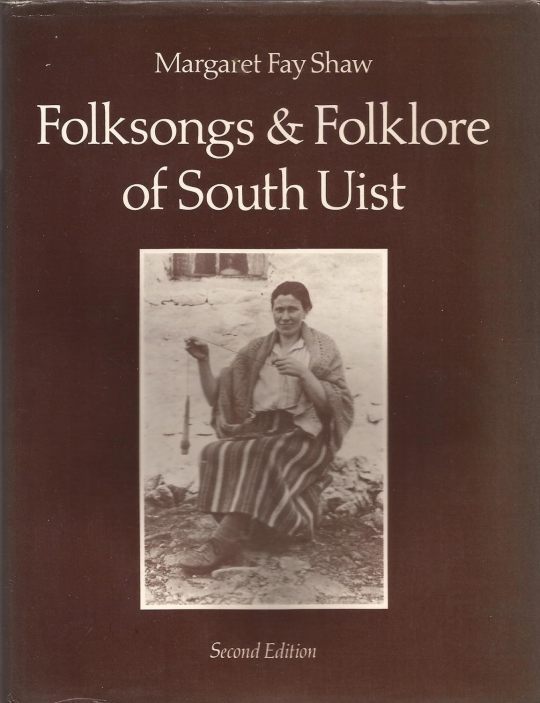


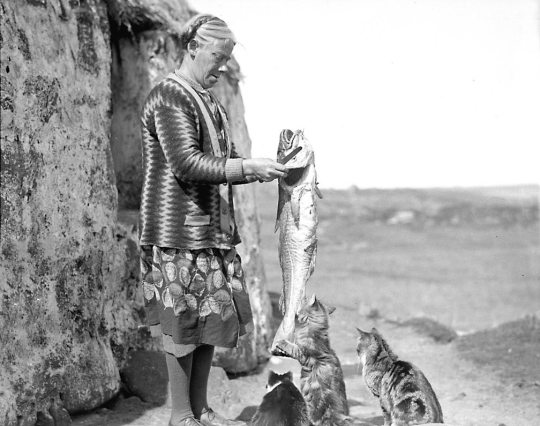


November 9th 1903 saw the birth near Pittsburgh of Margaret Fay Shaw, the American writer who did much to record the music and culture of South Uist.
Margaret Fay Shaw was one of the most notable collectors of authentic Scottish Gaelic song and traditions in the 20th century. The arrival of this young American on the island of South Uist in 1929 was the start of a deep and highly productive love affair with the language and traditions of the Gaels.
Shaw was also an outstanding photographer, and both her still pictures and cinematography contributed to an invaluable archive of island life in the 1930s. She met the folklorist John Lorne Campbell on South Uist in 1934; they married a year later and together helped to rescue vast quantities of oral tradition from oblivion.
She came of Scottish Presbyterian and liberal New England stock. The family owned a steel foundry in Pittsburgh and her parents were cultured people. Margaret was the youngest of five sisters and her early years were idyllic. Her first love was for the piano and she continued to play throughout her life.
By the age of 11, however, she was orphaned and obliged to develop the independence of character which was to lead her into a life's work far removed from her upbringing. At the age of 16, she made her first visit to Scotland at the invitation of a family friend and spent a year at school in Helensburgh, outside Glasgow, where she first heard Gaelic song.
Wanting to hear it in its "pristine" state, in 1924 she crossed the Atlantic again, this time engaging in an epic bicycle journey, which started in Oxford and ended at the Isle of Skye, where she remained for a month. It was during this trip that she began to use photography to earn a living, selling prints to newspapers, and magazines such as the Listener.
But it was not until she arrived on South Uist that she found her spiritual home. She was invited to the "big house" in Lochboisdale for dinner, and two sisters who worked there, Mairi and Peigi Macrae, were brought in to sing for the company. Margaret had never heard singing like it. For the next six years, she became their lodger and dear friend. They shared with her all of their immense stock of oral tradition which she faithfully transcribed, learning Gaelic as the work proceeded.
Her most important published work was Folksongs And Folklore Of South Uist, which has never been out of print since it was first published in full by Routledge and Kegan Paul in 1955. Not only was it a scholarly presentation of the songs and lore which she had written down during her sojourn on the island, but also an invaluable description of life in a small crofting community during the 1930s.
This classic work was undoubtedly the centrepiece of Shaw's career, though she also wrote several other books, including an autobiography, From The Alleghenies To The Hebrides.
On the neighbouring island of Barra in the early 1930s, an extraordinary social set - a kind of Bloomsbury in the Hebrides - had developed around the presence of Compton Mackenzie. One of his closest collaborators was John Lorne Campbell, who came from landed Argyllshire stock and had developed his interest in Gaelic at Oxford.
The two patricians set about producing The Book Of Barra, a collection of the island's history and traditions, to raise funds for an organisation called The Sea League, which they had established to campaign for the exclusion of trawlers from Hebridean waters.
Hearing great reports of an American woman's photography on South Uist, Campbell crossed over by ferry to seek her involvement in illustrating The Book Of Barra. He walked into the Lochboisdale Hotel one rainy evening in 1934 and found Shaw sitting at the piano; a suitably romantic initiation to a relationship which was to last for more than half a century. They married the following year and made their home on Barra until, in 1938, Campbell bought the island of Canna, where they lived for the rest of their scholarly lives. The island was given to the National Trust for Scotland in 1981, and John Lorne Campbell died in 1996.
There was nothing dry or academic, however, about Shaw. She travelled regularly to America until her late 90s. The fearsome ferry journey between Mallaig and Canna was regularly undertaken with equanimity, and she fortified herself to the end with the finest Kentucky bourbon. Her love of the Hebrides was, above all, for the values and lifestyle of the crofting people, and, particularly in South Uist in that 1930s heyday, it was deeply reciprocated. It is there that she will be laid to rest.
During her latter years she stayed at Canna House until her death at the grand old age of 101 in 2004.
98 notes
·
View notes
Photo

As some of Algy’s friends will already know, Algy invariably dyes his hair green on St. Patrick’s Day, for the beautiful island of Ireland is closer to the wild west coast of Scotland and the Hebridean islands - both physically and culturally - than to anywhere else on this earth ☘️
Algy saw no reason to diverge from his normal practice just because on the 17th March this year he happened to be relaxing on a magical tropical island, although it perhaps was not as close to the Emerald Isle as his regular home. But that of course might explain why St. Patrick had evidently not visited this particular island - a historical circumstance for which Algy was truly thankful, for he is very fond of snakes 🐍
Algy’s wishes you all a very Happy St. Patrick’s Day, and says:
Had I the heavens’ embroidered cloths,
Enwrought with golden and silver light,
The blue and the dim and the dark cloths
Of night and light and the half-light,
I would spread the cloths under your feet:
But I, being poor, have only my dreams;
I have spread my dreams under your feet;
Tread softly because you tread on my dreams.
☘️☘️☘️☘️☘️☘️☘️☘️☘️☘️☘️☘️☘️☘️☘️☘️☘️
[Algy is quoting the poem He wishes for the Cloths of Heaven by the 20th century Irish poet William Butler Yeats.]
#Algy#GIF#photographers on tumblr#artists on tumblr#st patricks day#happy st patricks day#animation#animators on tumblr#stop motion#tropical island#snakes#poem#poetry#he wishes for the cloths of heaven#william butler yeats#irish poetry#green hair#wearing the green#adventures of algy#original content
103 notes
·
View notes
Text
It's curious that white supremacists still latch onto medieval Scandinavians as an ideal of purity, when in reality they were a fine example of a culture that embraced and mixed itself with all those (Irish, Hebridean, English, Byzantine, Islamic, and so on) it encountered.
22 notes
·
View notes
Text

Gloucester History Festival : Call the Midwife, Q&A with Heidi Thomas and Stephen McGann. September 21st 2019. Blackfriars Priory.
Disclaimer: These are purely my thoughts and impressions as an audience member at this event (sat at the back). I didn’t make an audio recording or scribble any written notes. I haven’t got the greatest short-term memory in the world and I am human, so have a tendency to add my own interpretations to what I hear. Also there was a lot of content in almost an hour-and-half.
There aren’t any mind blowing revelations contained in my write up and I understand most fans will have knowledge of the subjects discussed in this talk. So I have to admit, I have therefore probably over shared my impressions of the event rather than the search for revelations . I have tried to provide an insight for fans who have not had the opportunity and privilege to listen to or meet either Heidi, Stephen or any of the CtM crew. It is incredibly difficult to do justice to the passion and enthusiasm of Stephen or reflect the clarity and intelligence of Heidi, but I have done my inadequate best.
I have failed to find out the name of the host, but what I do know is, he was excellent. He asked the right questions at the right times, without unnecessary interruption or pursuing his own agenda.
Just to get it out of the way, nothing new was revealed about series 9 apart from the political landscape that affected London in 1965. The CS was touched on, but only what we know regarding the Hebridean location, although there will also be a Poplar story involving Reggie. I was very relieved that Stephen, who as we know doesn’t interfere with Heidi’s writing, is dropping lots of World Cup hints for series 10. (For those who don’t know England held it and won it in 1966, we are talking football)
So to what was discussed:
Thalidomide was spoken about at some length, including the involvement of the Thalidomide community in reference to the story thread. I think a significant thing I picked up from listening to both of them talk concerning this and other topics, is how much the storylines affect the team. Obviously some have a personal edge, the Mrs Jenkins CS12 storyline was mentioned, touching on Stephen’s mam’s own story of the lost twin brothers told in Flesh and Blood. But I got the impression that every story is meticulously researched and also “lived” by Heidi in writing and the cast in trying to depict the human side to the historical facts.
What I was unaware of was how every person affected by Thalidomide developed completely unique combinations of deformities. So in the same way, Susan isn’t based on any particular person, her range of disabilities is unique to her, like it would be in reality. They didn’t say if there would be more Susan and the Mullucks’ in the future.
I hadn’t seen Heidi and Stephen interviewed together before and it is obvious how close they are. Stephen is well, I can’t think of a more appropriate word than besotted and uses every opportunity to compliment his wife. I felt Heidi is used to it, but by nature is very modest and would rather talk about other people’s input or Call the Midwife in general than her own achievements.
She is definitely a people person and is very happy to talk about Jennifer Worth and the original order that became the fictional Order of Raymond Nonnatus all day long. Both these relationships seem to have left a huge impression on her. It left me wondering what influence Jennifer would have now on CtM if she was still with us. Heidi did say that Jennifer, who in her own memoirs merged facts together to tell a good story, understood how drama works.
Which leads me on to another subject that was touched on, the shows authenticity. I found this particularly interesting because I love my history and I love research, archives, stats and all stuff nerdy. To try and sum up various strands of conversation; the impression I got is audiences can be very selective when it comes to authenticity.
They explained that sometimes it isn’t always possible physically, financially and legally (health and safety etc) to replicate everything perfectly, although they do go to ridiculously great lengths to do so. They used the example of a pram that was completely in keeping with the year it was featured, apart from the lining and this was picked up by viewers!!! But as Heidi explained the prams were reused frequently and often relined, so it’s very hard to find one today with the original lining.
This led to a discussion on what I call “selective desire for authenticity”, people want it to be realistic, but have difficulty accepting smoking Drs and nurses, drugs being prescribed to “cure” homosexuality etc. The audience having to accept that it is a mid-20th century show reflecting mid-20th century values and attitudes and that can make CtM a hard watch at times. (I must reiterate my words)
Heidi explained how since they moved on from Jennifer’s memoirs she starts each series by meticulously reviewing the medical statistics and reports for each particular year and that is where her inspiration comes from. She then has to translate this into drama and inject the human story. This struck me, as much as they aim for CtM to be as accurate as possible, sometimes dry facts just don’t tell a good tale and it’s the essence of the story that appears to be the priority, the human angle and truth behind the facts is what they are aiming to get right.
There was time for some excellent questions at the end, (someone mentioned something about alpacas but they were removed swiftly and appropriately by security). One lady explained her mother had been a Queen's Nurse in that era and I loved how she explained what an inspiration her mother had been to her. She touched on the fact that her mother and the nurses and midwives CtM are depicting were revolutionary, they were changing lives for women, pioneering independence, including continuing working after marriage and during motherhood, forging careers not just making ends meet. Something I have always thought needs highlighting and celebrating more. (My words here again, I need to clarify)
A lady asked if CtM will explore legal abortion as it has illegal. Heidi just explained those events are inline with series 10 and she hasn’t considered how she will tackle this, but as always she will try and highlight the main medical stories of each particular year as appropriate.
The final question from Di, asked what would Dr T think of today’s NHS? Heidi actually offered a lot of thoughts on this and explained that the NHS has never been perfect. Again, I can’t remember the exact words, but she implied it has always been over stretched because it’s always trying to reach forward and there has never been enough resources to fulfill its aims and ideals. “The goal posts are always moving” as I would say. She did say Dr T wouldn’t be happy.
Stephen talked about the dilemma we have now created for ourselves by the overuse of antibiotics (Heidi pointed out Dr T was part of the generation who created that problem). He also highlighted the anti-vaccine culture and how Dr T wouldn’t understand today’s thinking because he had seen those diseases up close and personal in his lifetime and wouldn’t be able to comprehend a generation who wouldn’t embrace a solution. (I emphasise these are my words from the impressions I got listening to their responses)
On a personal note; What a day I had! Gloucester was a mystery to me before yesterday and I have totally fallen in love with this stunning historic city and its cheery friendly folk. The venue Blackfriars Priory was perfect. Closing thoughts; Heidi and Stephen are genuinely lovely people who care very much about what they do and the people who appreciate what they do.
#call the midwife live#Heidi Thomas#Stephen McGann#Gloucester history festival 2019#al’s thoughts#do I get travel expenses
57 notes
·
View notes
Text
The Book of Kells: An Immortal Cultural Heritage of the Gaels
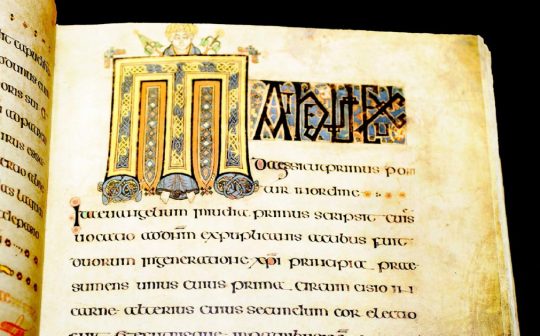
Over the centuries, from its earliest beginnings, Christianity was the inspiration for some truly stunning art. From early frescoes, to illuminated manuscripts , magnificent churches and abbeys, Christian art knew no bounds. And one such piece of art is the iconic and famed Book of Kells.
A historic heritage of early Christianity in Ireland, this magnificently illustrated gospel book is a clear glimpse into the unique art style and identity of the Gaelic peoples. Adorned with intricate details and a dazzling array of colors, this manuscript really shows the result of Christian tradition mixing with the art of the Gaels. And the result is truly stunning.
Dating from the 9th century AD, the manuscript luckily survived to the present day largely unscathed, and it withstood the wheel of time. Today we are bringing you the history of this marvelous art piece and getting you closer to the origins of Christianity in Ireland and the identity of the Gaelic nations. Join us!
Born From the Spirit: The Early Origins of the Book of Kells
When we consider early Christian art and illuminated gospels, there is hardly anyone who has not heard about the famed Book of Kells. Its reputation precedes it, and rightly so, as this is, to date, one of the finest and intricate pieces of illuminated gospels that we know of today. It is also the chief representation of the so called insular art style, and also its culmination.
Insular art refers to the unique form of art that originated on the islands of Ireland and Britain, and its name comes from Latin insula (island). Also known as Hiberno Saxon art, it flourished from 6th to 9th century AD. It is characterized by iconic features of Irish art which is today a chief part of Celtic Christianity, and its main features are truly stunning and complex knotwork interlace designs, La Tène Celtic art elements such as spirals, triskelions, knots, and symbols, Saxon animal motifs, and so on.
All of these elements of insular art are perfectly combined in the Book of Kells, making it a crowning representative of the style.
The exact origin and creation period of the Book of Kells is still largely debated, with several main versions existing. On the basis of the fully developed insular art style that encompasses all the features from the previous centuries, most scholars place the Book of Kells into the 9th century.
Now, the gospel itself is often brought into connection with Saint Columba, as being created by Columban monks, i.e. his followers. Saint Columba (orig. Irish - Colm Cille - “church dove”) died long before the 9th century, in 597 AD. He was an Irish missionary who is credited with successfully spreading Christianity among pagan Gaels and the Picts.
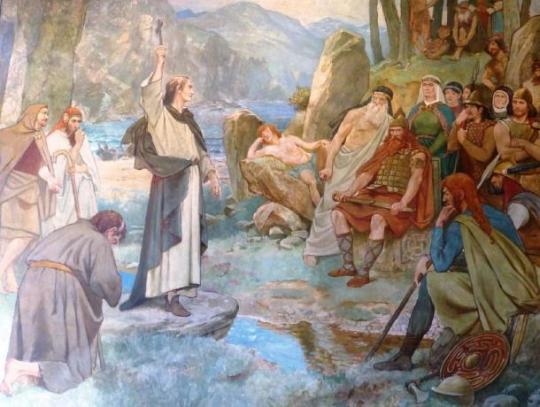
Saint Columba converting King Brude of the Picts to Christianity. (Kim Traynor / CC BY-SA 3.0 )
The original, old belief was that the Book of Kells was created during his lifetime, or even by Columba himself. But this tradition is usually dismissed on the basis of the complexity of the art style, which much more realistically belongs in the 9th century.
The other scholarly debate relates to the place of its creation. Most likely it was made on the island of Iona (Scottish: Ì Chaluim Chille ), a small island in the Scottish Inner Hebrides. The island is the site of the historic Iona Abbey and was the very center of Gaelic monasticism and the spread of Christianity for roughly three centuries. This was the place of the followers of Saint Columba, and if the Book of Kells was created there in the 9th century, it would coincide with the arrival of Vikings and the beginning of their raids.
Why is this important? Well, the manuscript is not called the Book of Iona, but the Book of Kells. Kells is a town in County Meath , Ireland, and the place of the Abbey of Kells.
Quite far from Iona, the abbey was created in the late 8th and early 9th centuries and was most likely a refuge for Iona monks who fled from the Viking raiders , bringing the Book of Kells with them. As the manuscript spent the longest period of time in this abbey, it was named the Book of Kells.
youtube
In summary, there are currently several proposed theories as to the origins of this manuscript. It is possible that it was created in the 8th century at Lindisfarne, and with the onset of Viking raids, was brought to Iona, and from there to Kells. It could have also been started at Iona and then finished at Kells.
But even at the Abbey of Kells, this magnificent manuscript was not entirely safe. In the 10th century, the place was repeatedly ransacked by Vikings, and at one point the manuscript was stolen. It was recovered later on, but not without loss – the gold and jewel adorned cover was not recovered. Even in that period, the worth and splendor of the manuscript was clear.
In the 1007 AD the Annals of Ulster , the book was named as the chief relic of the Western World . It then successfully survived in Kells and remained there until 1654. To preserve it from Oliver Cromwell’s troops, that arrived at the abbey in that year, the officials sent the book to Dublin, and from there it was given to Dublin’s Trinity College by the Bishop of Meath, in 1661. The Book of Kells remained there ever since.
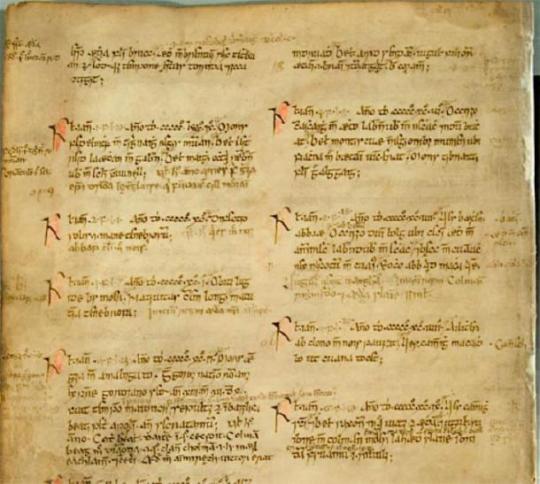
Spread the Word – Contents of the Manuscript
The Book of Kells consists of 340 sheets of fine vellum, which in turn totals 680 pages. It is comprised of the Four Gospels, and it is written in majuscule insular script, in yellow, red, purple, and black ink. The dimensions are 13 by 8.7 inches (330 by 220 millimeters), but these are the dimensions that resulted in a 19th century rebinding.

Interestingly, the Book of Kells seems to have never been finished. Several of the illuminations and decorations still remain only as outlines and were never filled and colored.
This ties in with the version that the manuscript’s completion was disturbed with the appearance of Viking raids. Either way, it is clear that this book was accomplished by a skilled team of monks in a scriptorium that was modern for its time, and that it most likely took them several years to accomplish.
It is written on a very fine vellum – aka animal skin or in this case the skin of a calf. It is thought that to produce the full Book of Kells, around 185 animals had to be killed to produce the vellum. Either way the quality is remarkable, although not all the pages are of same thickness – several are so fine that they are almost translucent.
The Book of Kells consists of preliminary writings and the Four Gospels – of Matthew, Luke, Mark, and John. The latter, Gospel of John, is incomplete, and goes only up to John 17:13 (And now come I to thee; and these things I speak in the world, that they might have my joy fulfilled in themselves.) The missing parts are generally attributed to the theft of the gold cover pages, which were torn off in the 10th century.
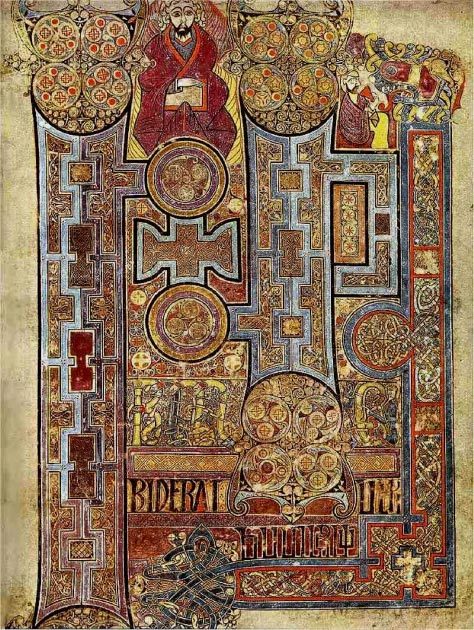
Of the preliminary writings, there are the Breves Causae (the Summaries of the Gospels), the Eusebian canons, and short biographies of the evangelists. All the writings are based from the Vulgate, a 4th century translation of the Bible into Latin. The Vulgate was completed by Saint Jerome in 384 AD.

The Book of Kells contains the symbols of the Four Evangelists (Clockwise from top left): a man (Matthew), a lion (Mark), an eagle (John), and an ox (Luke). (Magnus Manske / Public Domain )
As mentioned, there was a team of highly skilled scribes and artists from the abbey that worked on the book. All the big decorations were most likely produced by only three artists. There are subtle differences between each of the three, even though their names are unknown.
There were particular artists who did the major ornamental and interlaced knotwork designs such as the famous Chi Rho page. The stunning attention to detail and the mind dazzling intricacy of the woven lines is really amazing for the time period and is counted among the finest examples of Gaelic Celtic art.
The text was copied by four chief scribes. Slight differences can be observed through detailed studying of the writings, showing characteristic style shifts among the four.
It is observed that a particular scribe tended to repeat passages in order to fill up blank spaces on the page, as well as to use bright colors in the text itself. Another scribe did only the letters, avoiding decorations and leaving them to one of the artists.
Tedious Homework – Errors and Repetitions
An interesting glimpse into the trade network of the period can be seen from the many colors used in the Book of Kells. Most of these pigments had to be imported from abroad, often from quite far away, yet they still found their way to the small islands of Iona, Lindisfarne, and the Hebridean hermitages. The pigments were used for yellow, red, green, indigo, and blue.
Blue was made from woad, which was native to northern Europe, so that wasn’t such a problem to acquire. But the ochre for red and yellow, the verdigris green copper pigment, and lapis lazuli, all had to be imported from the Mediterranean. And in the case of ultramarine (lapis lazuli) it had to be acquired as far as Afghanistan.
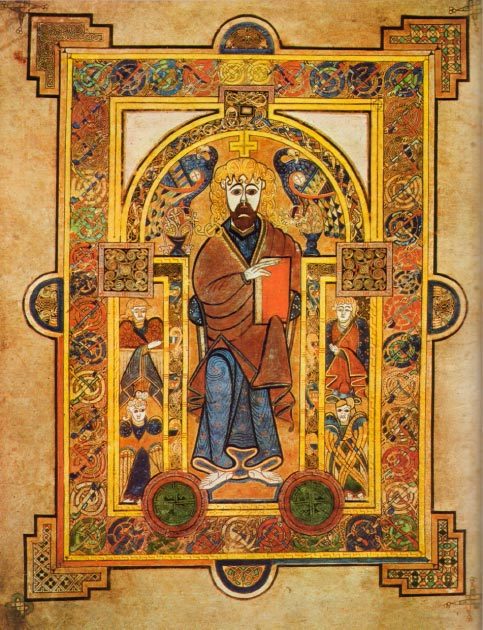
One surprising aspect of the Book of Kells is the seeming careless transcription, with numerous mistakes present throughout the manuscript. Granted, copying a manuscript takes a ton of concentration and dedicated effort, so mistakes can happen. Still, such a number of silly mistakes either tells us that the book had a more ceremonial use – not for daily use – or the Gaelic monks weren’t perfect masters of either the Latin language or insular script.
Words were skipped, pages repeated, and transcriptions wrong.
For example, the page 218 is a duplicate. It was clearly reproduced by mistake, but rather than discard it (it was a lot of hard work to produce even a single page) the monks chose to keep it in the book, nonetheless. The only thing that was done was the addition of numerous red crosses and red lines to indicate that the page should be ignored – as it was a mistake.
Also, there are plenty of errors in the text. A notable example is Matthew 10:34 (I came not to send peace, but a sword.) The original phrase in Latin should be: “Non veni pacem mittere, sed gladium.” But the scribe mixed gladium with gaudium, which means joy. Thus, the passage wrongly states: ”I came not to send peace, but joy.”
But in the end, the acceptance of such mistakes by the monks and the order tell us that it was really the aesthetics of the Book of Kells that were praised, rather than the written content itself. With almost all of the population at the time being illiterate, it was of no consequence that a word or two was wrongly written.
It was the grandiose look that had the purpose – to leave a lasting impression on the common folk, and to kindle belief in the hearts of the flock. And with the magnificent illustrations, with the mind boggling intricacy of the details, and the splendor of colors, we can safely assume that every common man of the time would be awestruck upon seeing the Book of Kells.
A Heritage to Last Centuries
Even though it is Christian in purpose and origin, the Book of Kells is still singlehandedly one of the most important insights into Irish and insular Gaelic art and culture. With numerous complex illustrations in this book, one certainly stands out. It is the page 34, with the full page illustration of the Chi Rho . Such an amazing level of detail, so many incredibly complex twists and interlaced designs, an abundance of La Tène Celtic art elements, bold colors, and endless depth, all tell us that the creation of even this single page could have taken many years.
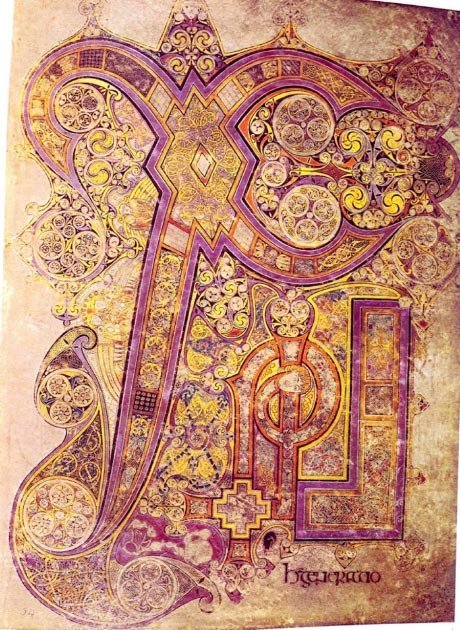
The Book of Kells contains the Chi Rho monogram. Chi and rho are the first two letters of the word Christ in Greek. (Soerfm / Public Domain )
And the whole of the Book of Kells was surely a product of much hard labor, dedication, and tedious transcription that was done by the monks. Those same monks who dedicated their lives to spiritual matters, and who so desperately yearned to secure their place in the imagined afterlife by carefully creating this immortal piece of Gaelic art.
12 notes
·
View notes
Text
First Pint with Bridget O'Malley #605
My first pint in Ireland this year is to Bridge O’Malley. The second is to the Irish & Celtic Music Podcast #605.
Old Blind Dogs, Bua, Norah Rendell, Conor Caldwell, Matt & Shannon Heaton, Enda Reilly, Tommy Fakem, Dervish, Low Lily, Iron Roux, Hot Griselda, Fast & Vengefully, Nick Metcalf, Heavy Blarney, Dàimh
GET CELTIC MUSIC NEWS IN YOUR INBOX
The Celtic Music Magazine is a quick and easy way to plug yourself into more great Celtic culture. Subscribe and get 34 Celtic MP3s for Free.
VOTE IN THE CELTIC TOP 20 FOR 2023
This is our way of finding the best songs and artists each year. You can vote for as many songs and tunes that inspire you in each episode. Your vote helps me create next year's Best Celtic music of 2023 episode. Vote Now!
Two weeks after the episode is launched, I compile your votes to update a playlist on Spotify and YouTube. These are the results of your voting. You can help these artists out by following the playlists and adding tracks you love to your playlists. Follow us on Facebook to find out who is added each week.
Listen on Spotify and YouTube.
THIS WEEK IN CELTIC MUSIC
0:02 - Intro: Carol Baril
0:10 - Old Blind Dogs "Desperate Fishwives" from Wherever Yet May Be
6:24 - WELCOME
7:55 - Bua "Eddie Moloney's / Micho Ressell's (Mason's Apron)" from Down the Green Fields
11:04 - Norah Rendell "Pretty Susan" from Spinning Yarns
14:48 - Conor Caldwell "An Art Revealed" from To Belfast...
17:17 - Matt & Shannon Heaton "The Blackbird" from Blue Skies Above
21:25 - FEEDBACK
23:50 - Enda Reilly "Gráinne Mhaol" from Single
27:30 - Tommy Fakem "First Pint" from Johnny Irish
31:10 - Dervish "Out On the Road" from Midsummer's Night
35:13 - Low Lily "Captivate Me" from Angels in the Wreckage
38:45 - STORY: Mark Clavey’s Whiskey Story and Tour
Find more about the Whiskey Lovers Tour on Mark Clavey’s website.
45:24 - Iron Roux "Wiru" from Iron Roux
50:19 - THANKS
52:19 - Hot Griselda "Roll On - Roll Off" from Sunbox
55:26 - Fast & Vengefully "The Price You Pay" from Rozzie Me Bow
1:00:25 - Nick Metcalf "Reel Rock" from Skyline of Skye
1:03:42 - Heavy Blarney "Heavy Carlow" from From Bog To Swamp
1:07:54 - CLOSING
1:09:09 - Dàimh "Dunrobin" from The Hebridean Sessions
The Irish & Celtic Music Podcast was produced by Marc Gunn, The Celtfather and our Patrons on Patreon. The show was edited by Mitchell Petersen with Graphics by Miranda Nelson Designs. Visit our website to subscribe to the show. You’ll find links to all of the artists played in this episode. You’ll get access to our Best of this Year Playlist.
Todd Wiley is the editor of the Celtic Music Magazine. You can subscribe to our Celtic Music Magazine and get 34 Celtic MP3s for Free. Plus, you’ll get 7 weekly news items about what’s happening with Celtic music and culture online. Best of all, you will connect with your Celtic heritage.
Finally, please tell one friend about this podcast. Word of mouth is the absolute best way to support any creative endeavor.
Promote Celtic culture through music at http://celticmusicpodcast.com/.
WELCOME CELTOPHILE TO CELTIC MUSIC
* Helping you celebrate Celtic culture through music. I am Marc Gunn. I’m a musician and podcaster out of Atlanta, Georgia. This Podcast is here to build our diverse Celtic community and help the incredible artists who so generously share their music with you.
If you hear music you love, please email the artists to let them know you heard them on the Irish and Celtic Music Podcast. You can find a link to all of the artists in the shownotes, along with show times, when you visit our website at celticmusicpodcast.com.
Do you have the Irish & Celtic Music Podcast app? It’s 100% free. You can listen to hundreds of episodes of the podcast. Download it now.
If you want an Irish & Celtic Music Podcast t - shirt, you can visit our store at MageRecords.com or you can also sign up to our mailing list. I’m planning a Kickstarter for this summer for a new album pin to promote the podcast. I’m starting to compile the Kickstarter page. You can be the first to be a part of this Kickstarter and get the pin, a shirt, a tote bag, and possibly more.
Go to BestCelticMusic.net to sign up.
THANK YOU PATRONS OF THE PODCAST!
Because of Your kind and generous support, this show comes out at least four times a month. Your generosity funds the creation, promotion and production of the show. It allows us to attract new listeners and to help our community grow.
As a patron, you get music - only episodes before regular listeners, vote in the Celtic Top 20, and you get a private feed to listen to the show. All that for as little as $1 per episode.
A special thanks to our newest Patrons of the Podcast: zachary g, Laura J L, Alex B
HERE IS YOUR THREE STEP PLAN TO SUPPORT THE PODCAST
Go to our Patreon page.
Decide how much you want to pledge every week, $1, $5, $10. Make sure to cap how much you want to spend per month.
Keep listening to the Irish & Celtic Music Podcast to celebrate Celtic culture through music.
You can become a generous Patron of the Podcast on Patreon at SongHenge.com.
TRAVEL WITH CELTIC INVASION VACATIONS
Every year, I take a small group of Celtic music fans on the relaxing adventure of a lifetime. We don't see everything. Instead, we stay in one area. We get to know the region through its culture, history, and legends. You can join us with an auditory and visual adventure through podcasts and videos.
In 2023, we’re going on a Celtic Invasion of County Mayo in Ireland. You can follow me on Instagram.com/celtfather if you want to see pictures during the event. Though I’ll also post at least once or twice on the Irish & Celtic Music Podcast Facebook page.
Learn more about the invasion at http://celticinvasion.com/
#celticmusic #irishmusic #celticmusicpodcast
I WANT YOUR FEEDBACK
What are you doing today while listening to the podcast?You can send a written comment along with a picture of what you're doing while listening.
Or how about a picture you took of a band that you saw. You can take a screenshot of the podcast on your phone.
How would you like to introduce an episode of the podcast? It’s super easy. Contact me for details.
Email me at celticpodcast@gmail, message me on Facebook, or contact me through Mastodon @[email protected].
Brett Mitchell replied to the Celtic Music Magazine: "Hi Mark, I make high end jewelry for a family owned store in the Grosse Pointe Farms area of Michigan. Truely enjoy your show and all the work you do on it.
Bonus answer: I'll likely head out to one of our local pubs for St Patrick's day and enjoy a Guinness or two. Slainte'"
Alexander Randall 5th replied: "What are you doing while listening? Sitting at my computer - working.
How are you celebrating Celtic culture through music this holiday season?
I decked out the Bear at the end of my driveway for the Saint
Jeff Laszlo replied: "Listening to The Bridge and making cookies and Irish soda bread before starting on corned beef. Slainte!"
Don W. Slee posted on Facebook: "When the internet is out and you can't work. Gotta make do. Slainte!!!"
Check out this episode!
0 notes
Photo

The UK just launched its first whale and dolphin-spotting trail
Sasha Brady - July 5, 2019
The UK now has its first whale and dolphin trail, a network of sites on Scotland’s west coast that offers opportunities for spotting marine mammals.
Sustainable marine tourism has just been given a boost in Scotland with the launch of the Hebridean Whale Trail. Developed by the Hebridean Whale and Dolphin Trust, the network of trails will put Scotland’s west coast on the map as a world-class destination for spotting dolphins, whales and porpoise from land, as well as championing the conservation of the Hebrides’ marine wildlife and environment.
The trail features 33 sites across the Hebridean archipelago and along Scotland’s west coast, from the Clyde to Cape Wrath in the north and as far west as St Kilda. While sightings can’t be guaranteed, there’s usually a good chance to see something special. More than a quarter of the world’s whale and dolphin species have been recorded in the region. Even if you miss out on whales or dolphins, you might just get the chance to spot other wildlife teeming in the Hebridean seas such as basking sharks and seals.
You can also get involved in marine conservation activities such as joining volunteers to watch, identifying and recording marine wildlife from land or by ferry and popping into visitor centres along the trail to learn more about the history, nature and culture of the trail’s unique communities.
“Scotland’s west coast is one of Europe’s best places to catch sight of whales, dolphins and porpoises from land and you may see bottlenose and common dolphins, harbour porpoise, minke whales and killer whales,” said Karl Stevens, Hebridean Whale Trail’s manager. “We want people from all walks of life to visit the Hebridean Whale Trail to enjoy exploring the region’s unique nature, culture and history, and to be inspired to support marine conservation.”
A website and map have been created especially for the new Hebridean Whale Trail. You can start exploring here.
4 notes
·
View notes
Text
Living Celtic languages in order of how fucked they are
(Most fucked on top, revived languages not included)
1. Brezhoneg/Breton - a Brythonic/ P-celtic language primarily spoken in Brittany/Breizh, France. Declining.
Second largest Celtic language at around 100 000 speakers but the average age is 77 and intergenerational transmission is completely broken, with a near-complete lack of support structures outside of the few families who still speak it - will be reduced to a few thousand within 20 years.
2. Gàidhlig/Scottish Gaelic (Pronounced ‘Gallick’, not ‘Gay-lick’) - a Goidelic/Q-celtic language primarily spoken in Scotland/Alba and in Nova Scotia/Alba Nuadh. Declining.
About 60 000 speakers, or around 1% of the population, but concentrated among the older generation. Intergenerational transmission broken and the languages is loosing its last strong communities in the Hebridean isles, unless drastic policy changes are introduced by the conservative SNP government. This will not happen. Gaelic has a stronger base outside of families through the school system, but unless children are brought up in completely Gaelic-medium schools, they will never speak Gaelic to eachother independently, since there will always be monolingual English-speakers. There are only three Gaelic schools without English streams.
3. Gaelige/irish (Pronounced ‘Gwelge’ in most dialects), a Goidelic/Q-celtic language primarily spoken in Ireland (North and South). Declining.
Around a hundered thousand regular speakers, though hard to find exact numbers. Same story as Scottish Gaelic. Intergenerational transmission collapsing, and learners from outside the Gaeltachts failing to compliment the lack of new Gaeltacht speakers combined with the collapse of the Gaeltachts as economic units through lack of support. However the language has strong support structures outside of these areas, through the Gaelscoil system, and the vast majority of irish people have a positive view of the Irish language.
4. Cymraeg/Welsh - a Brythonic/p.celtic language primarily spoken in Wales/Cymry and Patagonia. Growing.
At 450 000 or so speakers, or around 12% of the population, it is the largest celtic language by far. It has very broad support in Wales, a strong base in parts of the country where Welsh is the default language (arguably uniquely among the celtic languages), and enjoys broad support throughout the school system and the society as a whole, including in the culture. In my own judgement, the only one who’s likely to survive for more than two more generations, but all isn’t sunshine and roses as there have been signs that the support from the Welsh government might be flagging as the economic crisis deepens and Plaid Cymry moves further and further away from its roots.
#Common misconception#Breton is not descended from Gaulish but rather from settler from Britian who spoke Early Welsh#Celtic#langblr#gaelposting#This is VERY cursory if you want more details message me - might not be able to answer in detail concerning Breton though
2 notes
·
View notes
Text
Compartment 451
by ziamhaze
Zayn’s a muggleborn wizard whose parents leave him to fend for himself once he’s made aware of his magical abilities. The Payne’s, an open minded wizarding family, take him in to provide the boy with a loving home before he and their overly excited son Liam, go off to Hogwarts for the first time. Liam introduces Zayn to the wonderful world of magic, while Zayn teaches the pureblood about a way of life he’s never known. Somewhere between laser tag tutorials and petting Hebridean Black dragons, Zayn falls head over heels for the newly appointed Head Boy, but his three other nonconforming friends aren’t about to let the Ravenclaw go through his last year of school without letting Liam in on his feelings once and for all.
Words: , Chapters: 1/2, Language: English
Fandoms: One Direction (Band), Harry Potter - J. K. Rowling
Rating: Mature
Warnings: No Archive Warnings Apply
Categories: M/M, Multi
Characters: Zayn Malik, Liam Payne, Niall Horan, Harry Styles, Louis Tomlinson, Original Male Character(s)
Relationships: Zayn Malik/Liam Payne, Harry Styles/Louis Tomlinson
Additional Tags: Alternate Universe, Alternate Universe - Hogwarts, Pureblood Culture (Harry Potter), Muggle/Wizard Relations, Muggle-born Culture, Dean Thomas - Freeform, Angst, Friends to Lovers, ziam
via AO3 works tagged 'Harry Styles/Louis Tomlinson' http://bit.ly/2Me5TuZ
7 notes
·
View notes